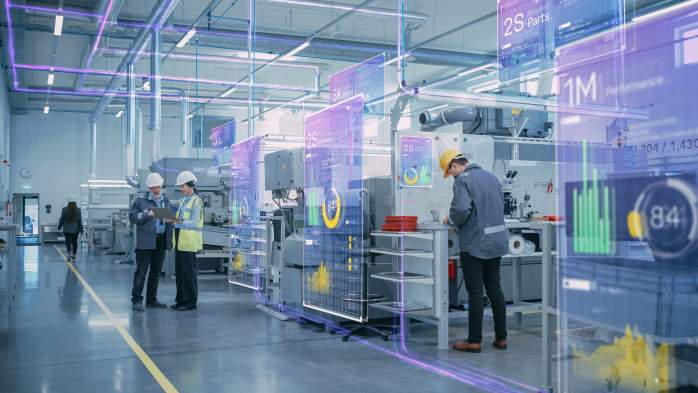America is in the midst of a manufacturing renaissance. The multi-trillion-dollar industry is on track to dramatically ramp up production, quality, and revenue generation. But to stay the course, manufacturing leaders need a well-staffed and well-equipped workforce.
That’s by no means a sure thing. By 2030, manufacturers could be short 2.1 million workers. The workers who remain will need to do more work at a higher quality to meet customer demand. Without efficiency-boosting tools, though, workers could wind up overstretched and burned out. The impact: more employee attrition, less-satisfied customers, and lower revenue.
Manufacturers are starting to recognize this and becoming more aware of how the technologies of the fourth industrial revolution can empower their workers to do their jobs smarter and faster. The companies producing and leveraging this technology are part of what McKinsey calls the “titanium economy.” Together, they’re paving the way for “industry 4.0”: a new era of smart manufacturing and industrial innovation.
This raises several questions for ITW companies:
How will data science and machine learning empower your company to better service customers, prevent downtime, and lower maintenance costs?
How will advanced analytics empower manufacturing leaders to make better decisions?
How do your machines need to evolve to keep up with the rapidly changing digital world?
In this piece, we’ll dig into all three.
With emerging technologies, the “smart factory” is a real possibility
The promise of the “smart factory” is a facility that assists workers and empowers them to think like business owners, making decisions that yield the biggest impact. Increasingly, industrial leaders understand this potential and are looking for ways to deliver it to their workers and their organizations.
Specifically, more and more manufacturing leaders are looking for equipment and tools that offer…
Predictive maintenance. Connected sensors can continuously collect usage data, then recommend maintenance based on actual usage rather than generic maintenance schedules.
Mobile-first intelligence: Predictive maintenance is helpful––but only if it’s offering predictions where customers are likely to see them. Mobile-first software ensures that customers get important messages in a timely manner, whether or not they’re in the lab and logged in.
AI-powered recommendations: Over time, data from connected sensors can “learn” how customers work and prompt them with common applications or tasks––the way your smartphone suggests your most-used apps when you pick it up first thing.
Manufacturing leaders are already looking for ways to leverage smart manufacturing to provide employees with more flexibility within existing frameworks. The key for companies is to develop technologies they’ll actually use––and devise a strategy to continuously improve that technology as customers’ needs evolve.
That strategy must involve deep user research to gauge users’ pain points. It must include a product vision that clarifies your technology’s audience, differentiators, and goals. And it should include a roadmap to keep your teams on course.
In the next section, we’ll look more closely at the key components of a sustainable IIoT innovation strategy that delivers highly usable products.
An innovation strategy can future-proof those who serve workers and factories
So what does it take to ensure that tech-enabled materials testing products actually resonate with customers? A value system called product innovation holds the key. Product innovation balances three considerations:
User desirability (i.e., what do customers want?)
Business viability (i.e., what can the company support?)
Technical viability (i.e., what's technically possible given real-world constraints?)
When an established manufacturer like wants to explore how new technologies might impact its products, product innovation ensures that any changes are optimized for usability, operational viability, and revenue generation.
In our experience, the hallmarks of sound product innovation in the manufacturing space include…
Bold ideation: Empower teams to think big and refine toward workable solutions.
Ongoing user research: Working backwards from insights and challenges sourced from end users should be the starting point of the development process and continue through launch and beyond.
Collaborative problem solving: Teams should be integrated with people from many disciplines working together to identify flaws and push toward strengths.
Learning from failure: This means learning to accept failure as part of the process of innovating, learning how to fail small to prevent catastrophic failures, and learning from failure to improve outcomes.
These practices are not part of the culture in many 85-year-old companies. That’s where an innovation partner can add value.
An innovation partner will interview users and company stakeholders to gauge their needs. They’ll help teams break down internal silos to get as many ideas as possible into the room. They’ll work together with engineers, designers, and leaders to select and prototype the best solutions. And they’ll make sure the company is equipped to consistently innovate for years to come.
Customer expectations are changing. Industry 4.0 can help ITW companies exceed them.
As a long-time trusted partner, the ITW brand and its counterparts are well positioned to evolve with its customers into the Industry 4.0 era. When you’re ready to talk more about how IIoT and other technology might transform your operations and those of your customers, get in touch.
Published
by
Jason Hehman
,
Andrew Horner




